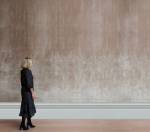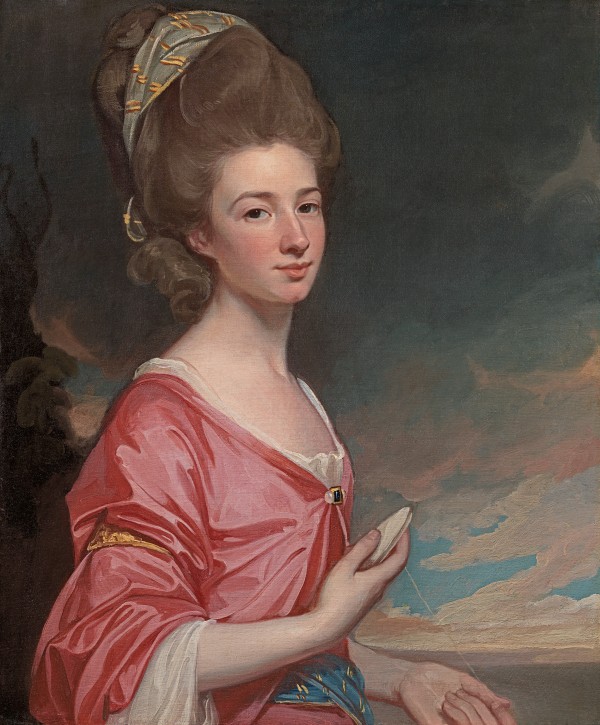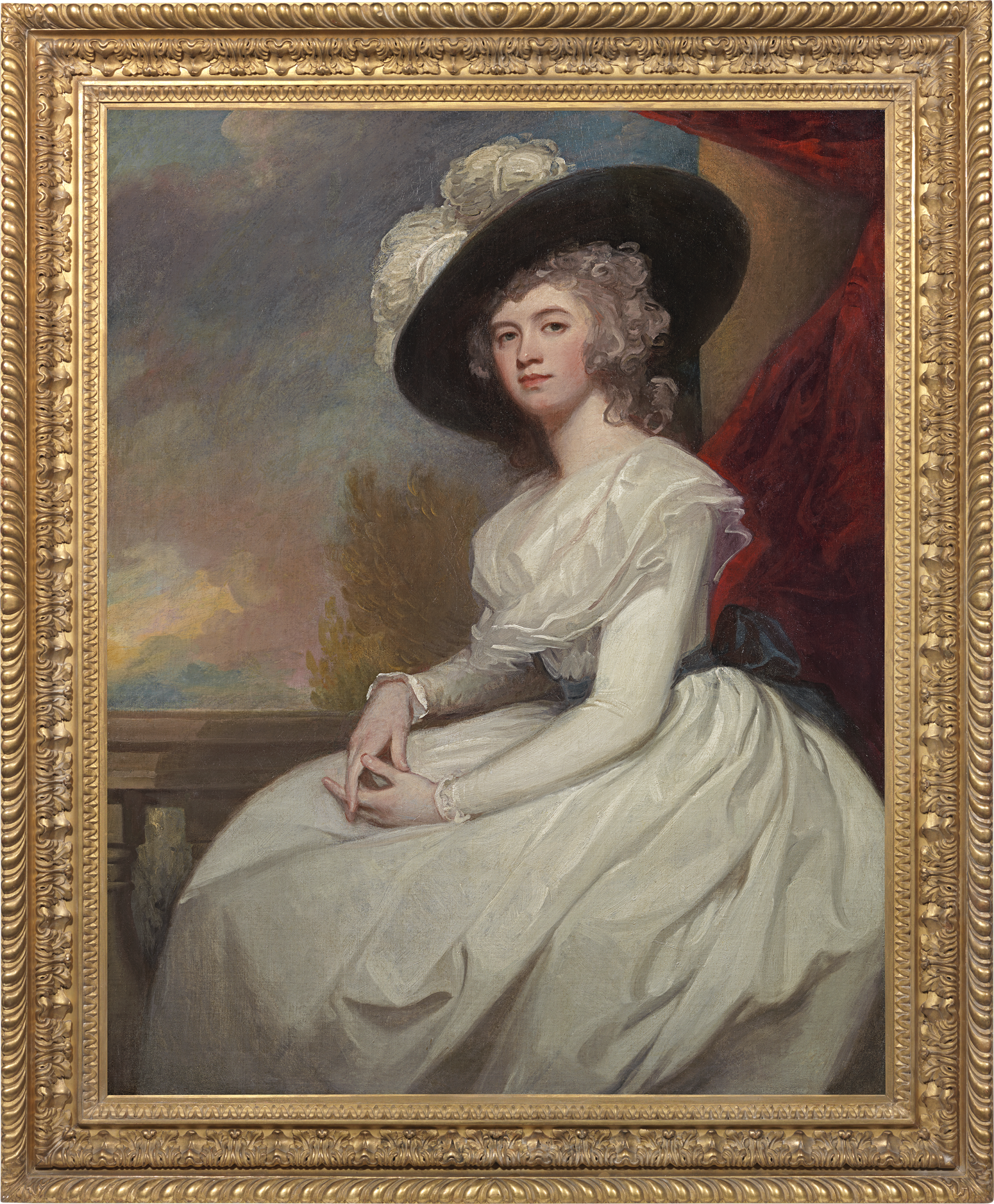GEORGE ROMNEY
Kendal, Cumbria Dalton-in-Furness, Lancashire 1734 - 1802
Ref: CC 107
Portrait of Frances Cooke, née Puleston (1765 – 1818)
Oil on canvas: 50 x 39 ½ in / 127 x 100.3 cm
Frame size: 59 x 49 in / 149.9 x 124.5 cm
Painted in 1787-89
Provenance:
Commissioned by the sitter’s husband, Bryan Cooke (1756-1821), Owston Hall, Doncaster, Yorkshire, and Gwysaney, Mold, Flintshire;
by descent to his great-grandson, Philip Tatton Davies-Cooke (1863-1946), Owston, Doncaster, Yorkshire, and Gwysaney, Mold, Flintshire;
from whom acquired by Duveen, New York and London, 1927;
from whom acquired by Jules Semon Bache (1861-1944), New York, 1927;
Bache Foundation, New York, 1944-1945;
from which acquired by the Metropolitan Museum of Art, New York, 1945;
by which sold in 2024 to benefit the Acquisition Fund
Literature:
G Paston, George Romney, London 1903, p.192 (engraved by H Greenhead)
H Ward and W Roberts, Romney: A Biographical and Critical Essay with a Catalogue Raisonné of his Works, vol. I, London 1904, pp.111, 119; vol. II, p.32
AB Chamberlain, George Romney, New York 1910, p.322
E Brandus, ‘La collection des tableaux anciens de M Jules S Bache, à New-York’, La Renaissance, no.11, May 1928, pp.184, 186
W Heil, ‘The Jules Bache Collection’, Art News, no.27, 27th April 1929, pp.4, 23, illus.
A Catalogue of Paintings in the Collection of Jules S Bache, New York 1929, n.p., illus.
AL Mayer, ‘Die Sammlung Jules Bache in New-York’, Pantheon, no.6, December 1930, p.542
A Catalogue of Paintings in the Bache Collection, New York 1937, n.p., no.61, illus.
Duveen Pictures in Public Collections of America, New York 1941, n.p., cat. no. 293, illus.
A Catalogue of Paintings in the Bache Collection, revised edition, New York 1943, n.p., no.61, illus.
‘English Portraits in the Jules Bache Collection’, Connoisseur, no.113, March 1944, pp. 54-55, illus.
JL Allen and EE Gardner, A Concise Catalogue of the European Paintings in The Metropolitan Museum of Art, New York 1954, p.85
J Steegman, A Survey of Portraits in Welsh Houses, vol. I, Houses in North Wales, Cardiff 1957, p.166, no.34
K Baetjer, European Paintings in The Metropolitan Museum of Art by Artists Born Before 1865: A Summary Catalogue, New York 1995, p.191, illus.
B Maclean-Eltham, George Romney: Paintings in Public Collections, Kendal 1996, p.23
M Secrest, Duveen: A Life in Art, New York 2004, p.485
K Baetjer, British Paintings in The Metropolitan Museum of Art, 1575-1875, New York 2009, pp.131-133, no.59, illus.
A Kidson, George Romney: A Complete Catalogue of His Paintings, vol. I, New Haven 2015, p.145, no.281, illus.; vol. III, p.856
Exhibited:
London, Royal Academy of Arts, Winter Exhibition, 6th January-14th March 1896, no.35
New York, Metropolitan Museum of Art, The Bache Collection, 16th June-30th September 1943, no.61
Indianapolis, Herron Museum of Art, The Romantic Era: Birth and Flowering 1750-1850, 21st February-11th April 1965, no.13
New York, Metropolitan Museum of Art, The Eighteenth-Century Woman, 12th December 1981-5th September 1982
The sitter in this fashionable society portrait is Frances Puleston, from an ancient family of landowners in North Wales. Her father, Philip Puleston, who died when she was an infant, owned the estate of Hafod-y-Wern, near Wrexham; whilst her mother, Mary Davies, was to bring the estate of Gwysaney, near Mold, into the Puleston family. With the death of her brother as a child, Frances was the sole heiress to both estates, an attractive marriage proposition for some lucky suitor.
Frances was twenty-one years old when, in December 1786, she married Bryan Cooke, a retired army officer nine years older than herself, who had inherited the estate of Owston on the outskirts of Doncaster the previous year. He was looking forward to the comfortable life of a country gentleman, improving his property and eventually, entering Parliament. Henceforward Frances’s life would be divided between her native Denbighshire and her husband’s county, where she spent most of her life (although Cooke did not neglect Gwysaney, and his descendants there took the name Davies-Cooke, living there into the twenty-first century).
In the six years before his marriage Cooke had sat to Romney for three different versions of a portrait of himself. All employed a simple ‘head and shoulders’ format, and although one depicted Cooke in uniform and two in civilian dress, they were similar in conception. Although Romney referred to one of them as a copy, Cooke in fact gave separate sittings for each picture, thus ensuring that that the likenesses reflected his gradual ageing process. He appears to have been a punctilious client who enjoyed some familiarity with the artist even if his requirements were modest.
For the portrait of his wife, begun some four months after their wedding, Cooke sought something grander. Rather than select the same canvas size as his own portraits and emphasise that he and his wife were a ‘pair’, he chose to draw a line under the portraits of his bachelorhood. The commission for a larger portrait told the story that his family horizons had enlarged; the portrait would be a symbol of dynastic momentousness. This type of formal disjuncture in marriage portraiture, while less common than the ‘pair’, was familiar enough: a favoured option especially where the wife’s connections or fortune were repairing or boosting those of the family of the husband.
The portrait of Mrs Cooke emerged in two stages. Six sittings in a period of three weeks in April and May of 1787 – a standard number – must have seen the portrait well advanced. However, at this point, Mrs Cooke’s first pregnancy intervened, and the work was resumed only in May 1789, when four more sittings saw the work completed. It is probable that Romney went over much of the portrait from scratch, for there are few visible pentimenti and the surface is not highly finished. He would, nevertheless, have retained the basic design, with the figure seated against a balustrade and column that establish its classical rectilinear structure; this is a stock one that Romney employed regularly in the mid-1780s and Mrs Cooke had probably selected it at the outset from exemplars hanging in the artist’s gallery. He would also have retained the white dress traditional for a female marriage portrait. Yet he would have necessarily adjusted the likeness itself, now that Mrs Cooke was a whole two years older; he must now have provided her with her up-to-the moment fashionable coiffure, and it was probably at this stage that he decided on the Rubensian hat – a common feature of his portraits of ladies at this period – which visibly lies over the column behind it. In order to unify the work he would have added the final translucent glazes all across the surface.
What has been described so far, in terms of design, costume, and painting process, might be called the epitome of Romney’s female society portraiture. The individuality of the portrait consists in its subtle modification of its norms. Thus while at first sight Mrs Cooke’s expression might seem bland, her features regular, her prettiness conventional, a closer reading of her face surely suggests hidden ambiguities: there is the combination, like the notes in a complex wine, of her faraway, distant gaze and at the same time an element of immediate confrontation, almost pugnaciousness. Romney’s mastery of individual expression, noted regularly by his contemporaries, is well to the fore here. In similar fashion, Romney tweaks the basic principle of the design – rectilinearity offset by the sweeping diagonals that descend from upper right to lower left – through a series of formal measures that disrupt and complicate. To this end, the abstract shapes and colours of the hat are significant features. So are the rich and melting forms of the sky, the awkward folds of the red drape, the blue bow at Mrs Cooke’s waist, and the seemingly vacuous, but formally critical tree in the centre ground. Mrs Cooke’s interlocking hands create a visual highlight at the centre of the composition from which the eye is drawn backwards along the right forearm into an ambiguous space, the very centre of the composition, that might almost be continuous with the tree behind. Under a pervading ambience of elegant simplicity, Romney unlocks an armoury of devices that reward and entertain the viewer’s roving eye.
Alex Kidson
Note on the provenance
The history of this painting reflects the enthusiasm among American collectors for eighteenth century British portraiture in the latter years of the nineteenth century and the early part of the twentieth. Magnates such as Andrew W Mellon, Henry Huntington and Henry Clay Frick acquired works by Gainsborough, Reynolds and Romney to enhance interiors strongly influenced by European aristocratic taste. Many were nimbly sourced for this market by the British art dealer Joseph Duveen, who helped to build many outstanding American collections. He acquired the Portrait of Frances Cooke from Philip Tatton Davies-Cooke (1863-1946) in 1927 and sold it the same year to the New York stockbroker and industrialist Jules Semon Bache (1861-1944). Bache was a major patron of the arts. After his death, most of his paintings, including Giovanni Bellini’s Madonna and Child, Hans Holbein’s Derick Berck and Frans Hals’s Portrait of Claes Duyst, were given to the Metropolitan Museum of Art, New York. They included the Romney, recently deaccessioned by the museum to build funds for future purchases.
George Romney, Bryan Cooke, 1780-81. Frances Cooke’s husband.
Owston Hall, near Doncaster.
GEORGE ROMNEY
Dalton-in-Furness, Lancashire 1734 – 1802 Kendal, Cumbria
George Romney ranks with Reynolds and Gainsborough as one of the finest society portrait painters of the eighteenth century. The son of a cabinetmaker, he was apprenticed first to his father and then in 1755 to the itinerant portrait painter Christopher Steele. In 1757 Romney set up a portrait practice in Kendal.
In 1762 Romney left his wife and family in Kendal and moved to London to seek his fortune. He specialised in portraits and historical pictures such as The Death of General Wolfe, shown at the Society of Arts in 1763. The following year he visited Paris, but was dismissive of modern French art. Romney’s society portraits of 1764-73 show a grandeur of treatment and a graceful, elongated neoclassical style.
Romney went to Rome in 1773 with the miniature painter Ozias Humphry, in order to study Italian art, particularly the work of Michelangelo and Raphael. Although he had a reputation for reclusiveness, Romney’s broadly-brushed pen and ink drawings of dramatic figural scenes have affinity with the work of Abildgaard, Sergel, Joseph Wright of Derby and other members of the Fuseli circle in Rome.
Romney returned to England via Florence, Bologna, Ferrara, Venice and Parma in 1775. He took a lease on Francis Cotes’s grand house at 24 Cavendish Square and quickly re-established his portrait practice. His sitter books record some 1500 sitters between 1776 and 1795; he excelled at painting beautiful and glamorous society women, their elegant poses informed by the study of Italian art. Romney hankered after success as a history painter and produced a painting of The Tempest for Boydell’s Shakespeare Gallery in 1790, as well as his many portraits of Emma Hamilton (then Emma Hart) in allegorical or classical guise. These portraits of Emma are a perfect fusion of Emma’s theatrical instinct with Romney’s Romantic bravura brushwork; his love for her was not requited.
Visiting Revolutionary France in 1790, Romney admired a flourishing school of history painting in the work of David and other neoclassical artists. His instinct to express himself as a history painter found vent in numerous dashing, emotionally charged drawings, including many on subjects from Milton, but in few large history paintings. In 1798 Romney moved to a new large house and studio in Hampstead, but soon after suffered a series of strokes. The following year he moved back to his long-neglected wife in Kendal and died there in 1802. He was a melancholy, sensitive man, who triumphed in his chosen sphere of portraiture but always longed for recognition in the so-called ‘higher’ category of history painting. His friend Flaxman wrote of him: ‘his heart and soul were engaged in the pursuit of historical and ideal painting’, but his stunning portraits are among the most impressive of his century.
The work of George Romney is represented in the National Portrait Gallery and the Tate Gallery, London; the Museum of Fine Arts, Boston and the Huntington Art Gallery, San Marino, California.

![George Romney - Portrait of Frances [nee Puleston] Cooke [1765 - 1818]](/oimgnn/images_products/HD_CC107-500.jpg)
![George Romney - Portrait of Frances [nee Puleston] Cooke [1765 - 1818] George Romney - Portrait of Frances [nee Puleston] Cooke [1765 - 1818]](/images_products/L_CC107.jpg)
![George Romney - Portrait of Frances [nee Puleston] Cooke [1765 - 1818] George Romney - Portrait of Frances [nee Puleston] Cooke [1765 - 1818]](/images_products/L_CC107F.png)


![George Romney - Portrait of Frances [nee Puleston] Cooke [1765 - 1818] George Romney - Portrait of Frances [nee Puleston] Cooke [1765 - 1818]](/images_products/T_CC107.jpg)








